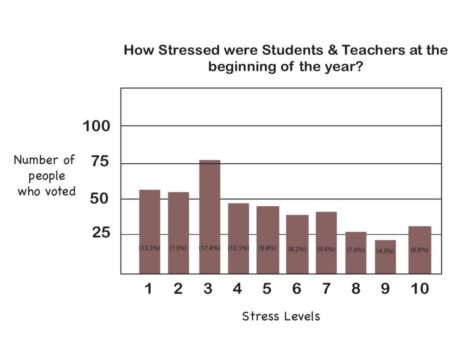Mid-Year Slump
Students and teachers open up about their middle of the year stressors and ways to help them feel more successful.
November 24, 2021

 As the middle of the school year approaches, so does a negative mindset, that causes many students and teachers here to experience higher levels of stress. Although this time of year can be difficult, there are ways that students and teachers both destress.
As the middle of the school year approaches, so does a negative mindset, that causes many students and teachers here to experience higher levels of stress. Although this time of year can be difficult, there are ways that students and teachers both destress.
There are multiple ways in which high school students can experience stress. For example, too much homework and not enough downtime can be common stressors. Oxfordlearning.com shares that relationships, harder classes such as advanced placement (AP), classes with extra homework and parental pressure to get good grades are all factors that can add stress to teenagers’s lives.
Dezi Honeicke ‘22 is one of many students who personally struggle; “I’ve had to make up a ton of assignments.” Grace Godfrey ‘22, who agrees, said, “I’d say my classes are why I’m stressed because I’m taking all of my required courses including my first AP course.”
Other students have felt the stress since the first day of school. “I feel like in the beginning, I was very on top of things, like I didn’t really have many missing assignments or anything,” said Laura Thangi ‘24. “It’s just got really stressful. I miss like one day of school and everything just piles up from there.”
One can argue that teens feel the effects of stress year-round. But why does it hit so hard during this time of year? “We’re kind of entering that little area where you start to get slumped because the breaks are coming up soon and it just feels like everything is piling up,” Thangi said.
Teachers have also been feeling this way. Psychology teacher Jesse Dowell said, “The last couple days before break, we tend to have a decrease in motivation and I feel that’s pretty typical.” Government teacher Thurston Gable agrees by saying, “I’ve noticed some students tend to hit the wall… they lose motivation and they start to view school more and more like a job which, sometimes I can’t blame them.”
Teacher stressors are not noticed as much by students, however, they do still exist. According to Chalkbeat.org, a recent poll showed that more than three in four teachers experience high levels of stress every day. This is tying teaching with nursing as the most stressful occupation in the United States. It has also been found that 30% of teachers end up abandoning their profession altogether within the first five years.
Additionally, teachers can feel the effects of mid-year stress as well. “Some teachers handle stress differently, there are some teachers who start to shut down more, or they start to get short and lose their patience,” Gable said.
This is not very surprising, as most of the stressors teachers experience on a daily basis are not easy to deal with. Ibcces.org also explains that inattention during class, hostility towards the teacher, and hyperactivity are just a few of the things that add stress to a teacher’s life. “I’m getting used to being in a new district so there’s obviously some adjustments with that,” Gable says.
Since students and teachers alike experience the effects of a mid-year mindset, something needs to change. Asking students what they do to destress and stay motivated provided a lot of shocking evidence of students being in a slump.
Bre Bolken ‘22 said, “I will spend hours upon hours watching shows and to destress, I just play games on my phone – like Bejeweled.” However, Honeicke says, “I like to draw and listen to music.”
Some common stress-reducers that students can do on their own include deep breathing, muscle relaxation, meditation, and talking to others. Accreditedschoolsonline.org also suggests that journaling, yoga, and staying active can be effective ways to combat stress.
The Counseling Office is a great space to relax if one is having trouble and even offers a relaxation room. “I’ve been doing a lot of things that I enjoy and if I’m feeling stressed I usually just go to the counseling office and they’ll let me just chill there for a little bit,” Thangi said.
Another way to reduce stress for students is to provide more structure. One way students can receive structure is through teachers checking up on them more often. “I do weekly check-ins and most kids are like ‘yeah, okay’,” Dowell shares. “I always end up having a few in every class who are like ‘I’m honestly not that great’. I don’t know if it fixes everything, but I hope caring and looking out for my students helps.” Teachers can also reduce how much stress students experience by limiting workload and homework, as well as keeping students active and playing music to create a more welcoming class environment.
A couple of ways parents can help their child(ren) reduce their amount of stress is to not over-schedule them. Teenagers need time to decompress. Accreditedschoolsonline.org also suggests parents and guardians ensure the correct amount of sleep for their children and encourage teens to shut off screens. Mental health professional Stefanie Juliano says, “Getting a good night’s sleep is also important as well as a balanced meal in the morning is a helpful way to deal with stress.”
In conclusion, the mid-year slump takes a toll on everybody. Remember to be patient and understanding with one another during this seemingly difficult time, and when you are struggling, just remember, “We’re here, guys. We’re gonna be okay,” -Gable.




